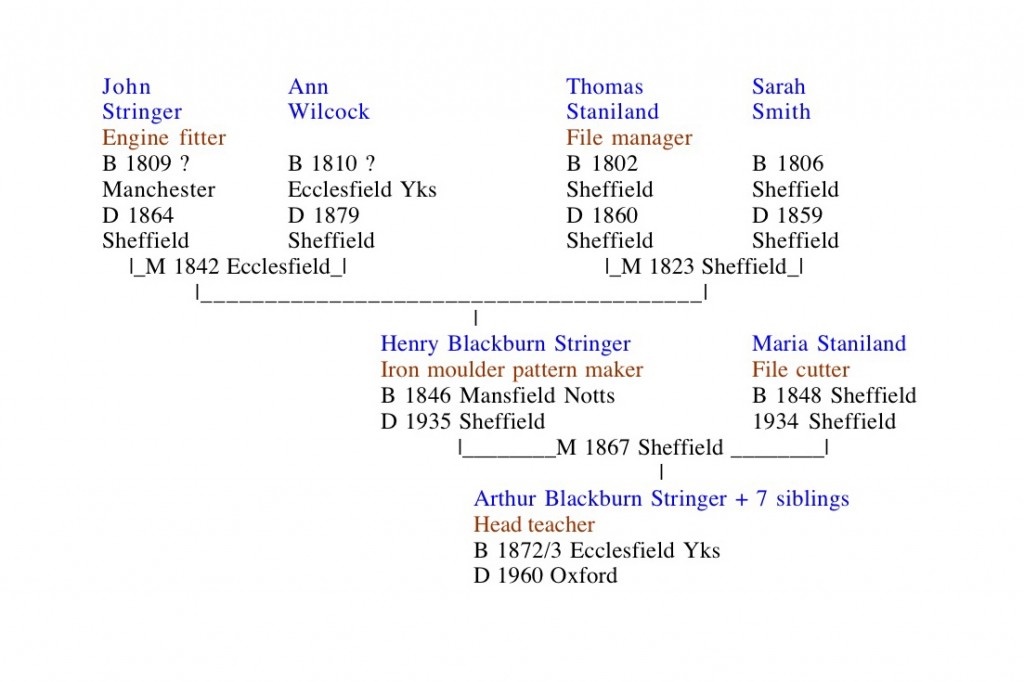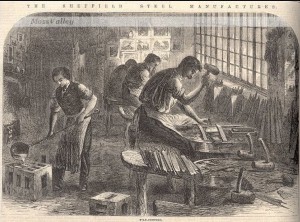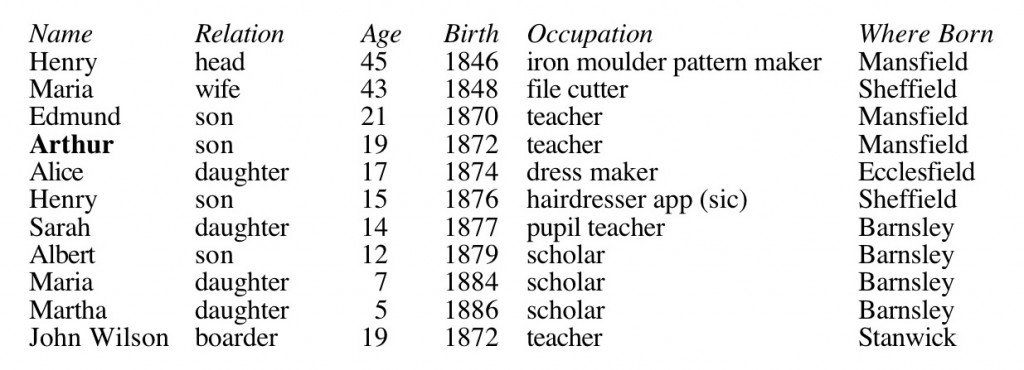Stanilands
The Staniland Connection
Henry Blackburn Stringer married Maria Staniland in 1867.
It is this marriage of our great grandfather, Henry Blackburn Stringer, to Maria Staniland which introduces the name Staniland into the family. I assume that in some way she must have been an important or influential presence in Mum’s family because her son, Frank, carries her surname as a Christian name and Mum’s elder brother, Harry, was also named Staniland. (There are a couple of records of the name written as Stainland. These may be misprints or it may be that Staniland glosses a somewhat unwelcome appellation.)
The extract from Arthur’s family tree, below, may help when following Arthur’s life story.
One can trace Maria’s family a generation further back than Henry’s family. Maria Staniland’s father was Thomas Staniland who was born at Sheffield in 1802 and he died at Sheffield in 1860. He had married Sarah Smith, born in 1823, at Sheffield Cathedral.
Sarah was born at Sheffield in 1806, see her birth certificate below, and she died there in about 1859.
Her birth was registered by her mother, Sarah. It is difficult to read on the copy above but she signed the form with ‘her mark’, a cross which indicated that she was illiterate. Thomas was also baptised at Sheffield Cathedral. He became a file smith and then a file manager according to the census returns. His wife was also a file smith. They had five children, the youngest being Maria Staniland who was born in 1847/8 and who married Henry Blackburn at St George’s Church, Sheffield in 1867. She died at Sheffield in 1934. She was a file cutter. Thomas Staniland’s parents were named George Staniland and Sarah Stavely and they, too, were married in Sheffield Cathedral. George Staniland was born in Sheffield in 1763 and died there in 1849. His wife, Sarah Staveley was also born in Sheffield in 1771 and died in the same year as her husband in 1849. George Staniland’s father was John Staniland, born in 1740.
The Stanilands must have had strong Church of England connections since Thomas was baptised and married at Sheffield Cathedral and his daughter, Maria, married Henry Blackburn Stringer at St Georges Church, Sheffield, which was a substantial and imposing civic church. This Anglican influence was probably very important in Arthur Blackburn Stringer’s formative years. That memberes of the family married in the Cathedral and an important Church suggests that they may have been a family of some substance in the community.
An interesting aspect of the Stanilands is their occupation as file cutters. For the history and description of file cutting, see here. At first sight one may think that this was a peripheral occupation of little consequence. It was, however, a trade of vital importance for the metal and tool making industries developing in Sheffield during the Industrial Revolution since the file was an essential tool in the manufacture of other small tools and cutlery. Moreover file cutting was an extremely dangerous occupation with a low life expectancy for people who worked in the trade. This is because lead was used in the manufacturing process and caused widespread lead poisoning, see the article from the Britsh Medical Journal, 1857. Maria Staniland was lucky to live as long as she did. I assume that her farther worked his way up to becoming a supervisor or manager of a file cutting firm. File cutting was also a suitable trade for married women, such as Maria, who could work at home cutting small files. The lead dust cannot have done much for the health of the family.
The 1871 Census records Henry and Maria as living at Ecclesfield with their first child Edmund, then an infant. Also living with the family was an eleven year old nephew, Tom Briggs Cross, a scholar. Henry was an iron pattern maker and Maria was a file cutter. At the time Ecclesfield was a village in open country to the north of Sheffield but one can appreciate why the family became established there. There were coal mines and two iron foundries close by and it became a centre for light metal trades including nail making, file making and cutlery manufacture. The occupations of people living close to the Stringers included file cutters, brace bit grinders and blacksmiths. Moreover, Stringer was quite a common name in the village so they may have had other relatives living close by.
By the time of the 1881 Census the family had moved to 43 Oxford Street, Barnsley. Henry was recorded as a machinist engine model maker. This job description indicates that he made and operated machinery. By this time there were six children in the family and the eldest four were at school, namely: Edmund, 11; Arthur, 9; Alice, 7; and Henry, 5. The two youngest: Sarah, 4; and Albert, 2, had yet to start school. Arthur was to become the father of our mother, Alice Muriel. The house still stands and is a modest, narrow stone built terrace house with a slate roof, see below. It is difficult to imagine a family with six children squeezed into such a small home.
By the time of the 1891 Census the family had moved again, this time to 49 Cemetery Road, Barnsley. The household consisted of
This house still stands and it is a mid terrace house, larger than the Oxford Street home, and stone fronted with a slate roof and an attic bedroom. It is quite a deep building and it may have had four bedrooms. Possibly the family had moved to this more substantial home to accommodate the growing household. Nevertheless one wonders how eight adults and three children managed to squeeze into the house, let alone live in reasonable comfort.
Arthur continued living in the family home and the years between 1881 and 1891 must have seen important developments in his young life. By 1891 both Arthur and his elder brother, Edmund, were working as board school teachers . Board schools were set up in the 1870s by Local Education Boards often in opposition to Church schools. They will have become teachers through the Pupil Teacher System which was introduced in the mid 19th Century to remedy deficiencies in the Monitorial System. For more information about pupil teachers, see here. Thus Arthur will have left school and begun work as a pupil teacher in about 1885 and become qualified in 1890 when he was 18. Presumably both Edmund and Arthur had been identified as able pupils at the age of thirteen. We may assume that their parents valued learning and education since they allowed both elder sons and their younger daughter, Sarah, to remain in the school system training to be teachers while making only a small contribution to the family finances. They would, however, have been well placed to take advantage of the introduction and development of compulsory education following the passing of the 1870 and 1880 Education Acts.
The father, Henry, had become an iron moulder pattern maker but one wonders how different this work was from his previous job. The other children in the family included: Alice 17, a dress maker; Henry 15, a hairdresser’s apprentice (the record is correct); Sarah, 14, a pupil teacher; Albert 12, scholar; Maria 7, scholar; and Martha 5, scholar. It is noteworthy that all these children had survived. There was also room to have a nineteen year old elementary school teacher boarding at the house. Addresses and birth places indicate that the family must have been quite mobile for the time, see the map below. The family provides a splendid example of teaching being one of the key professions which provided the transition from a manual, skilled working-class background to non manual middle-class employment during the era when England was changing from a predominantly agricultural society to an industrial one.
The occupations recorded on the 1891 Census for members of the families living in the five houses each side of 49 Cemetery Road included: coalminer, assistant mining engineer, general servant, engine fitter, iron pattern maker, postman, draper’s assistant, tailor, three elementary school teachers, shoe maker, clicker bookmaker, milliner, butcher, blacksmith’s apprentice, gardener, gas fitter, and water engineer.
The story of Arthur’s life and the crucial years continues here.











